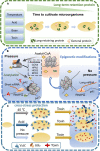Microbial Adaptation to Enhance Stress Tolerance - PubMed (original) (raw)
Review
Microbial Adaptation to Enhance Stress Tolerance
Yong-Shui Tan et al. Front Microbiol. 2022.
Abstract
Microbial cell factories have been widely used in the production of various chemicals. Although synthetic biology is useful in improving the cell factories, adaptation is still widely applied to enhance its complex properties. Adaptation is an important strategy for enhancing stress tolerance in microbial cell factories. Adaptation involves gradual modifications of microorganisms in a stressful environment to enhance their tolerance. During adaptation, microorganisms use different mechanisms to enhance non-preferred substrate utilization and stress tolerance, thereby improving their ability to adapt for growth and survival. In this paper, the progress on the effects of adaptation on microbial substrate utilization capacity and environmental stress tolerance are reviewed, and the mechanisms involved in enhancing microbial adaptive capacity are discussed.
Keywords: adaptation; cross-protection against stress; epigenetic modification; microorganisms; synthetic biology; transcription factors.
Copyright © 2022 Tan, Zhang, Liu, Li and Yuan.
Conflict of interest statement
The authors declare that the research was conducted in the absence of any commercial or financial relationships that could be construed as a potential conflict of interest.
Figures
FIGURE 1
Microbial stress adaptation. (A) Schematic diagram of long-term adaptation of microorganisms to their environment. (B) Schematic diagram of short-term adaptation of microorganisms to their environment.
FIGURE 2
Mechanisms of microbial stress adaptation. (A) When microorganisms are subjected to environmental stress, the long-retaining proteins are produced to protect the cells for a long time. (B) Effects of environmental stress on microbial epigenetic modifications. When microorganisms are stimulated by external environmental stress, epigenetic modifications are altered, affecting transcription and translation processes. (C) Microorganisms are adapted to a stressful environment, resulting in cross protection against stress. Growth advantages can also be shown when switching to other stressful environments.
Similar articles
- Microbial physiological engineering increases the efficiency of microbial cell factories.
Liu H, Qi Y, Zhou P, Ye C, Gao C, Chen X, Liu L. Liu H, et al. Crit Rev Biotechnol. 2021 May;41(3):339-354. doi: 10.1080/07388551.2020.1856770. Epub 2021 Feb 4. Crit Rev Biotechnol. 2021. PMID: 33541146 Review. - Advances in stress-tolerance elements for microbial cell factories.
Kuang Z, Yan X, Yuan Y, Wang R, Zhu H, Wang Y, Li J, Ye J, Yue H, Yang X. Kuang Z, et al. Synth Syst Biotechnol. 2024 Jun 28;9(4):793-808. doi: 10.1016/j.synbio.2024.06.008. eCollection 2024 Dec. Synth Syst Biotechnol. 2024. PMID: 39072145 Free PMC article. Review. - [Tolerance engineering regulates stress resistance of microbial cell factory].
Zhang L, Gao J, Liu C, Deng L. Zhang L, et al. Sheng Wu Gong Cheng Xue Bao. 2022 Apr 25;38(4):1373-1389. doi: 10.13345/j.cjb.210726. Sheng Wu Gong Cheng Xue Bao. 2022. PMID: 35470613 Chinese. - Engineering of global regulators and cell surface properties toward enhancing stress tolerance in Saccharomyces cerevisiae.
Kuroda K, Ueda M. Kuroda K, et al. J Biosci Bioeng. 2017 Dec;124(6):599-605. doi: 10.1016/j.jbiosc.2017.06.010. Epub 2017 Jul 13. J Biosci Bioeng. 2017. PMID: 28712705 Review. - Enhancing stress-resistance for efficient microbial biotransformations by synthetic biology.
Jia H, Fan Y, Feng X, Li C. Jia H, et al. Front Bioeng Biotechnol. 2014 Oct 20;2:44. doi: 10.3389/fbioe.2014.00044. eCollection 2014. Front Bioeng Biotechnol. 2014. PMID: 25368869 Free PMC article. Review.
Cited by
- Solar park promoted microbial nitrogen and phosphorus cycle potentials but reduced soil prokaryotic diversity and network stability in alpine desert ecosystem.
Liu Y, Ding C, Su D, Wang T, Wang T. Liu Y, et al. Front Microbiol. 2022 Sep 8;13:976335. doi: 10.3389/fmicb.2022.976335. eCollection 2022. Front Microbiol. 2022. PMID: 36160250 Free PMC article. - Improving 5-(hydroxymethyl)furfural (HMF) tolerance of Pseudomonas taiwanensis VLB120 by automated adaptive laboratory evolution (ALE).
Lechtenberg T, Wynands B, Müller MF, Polen T, Noack S, Wierckx N. Lechtenberg T, et al. Metab Eng Commun. 2024 May 10;18:e00235. doi: 10.1016/j.mec.2024.e00235. eCollection 2024 Jun. Metab Eng Commun. 2024. PMID: 38832093 Free PMC article. - StressME: Unified computing framework of Escherichia coli metabolism, gene expression, and stress responses.
Zhao J, Chen K, Palsson BO, Yang L. Zhao J, et al. PLoS Comput Biol. 2024 Feb 12;20(2):e1011865. doi: 10.1371/journal.pcbi.1011865. eCollection 2024 Feb. PLoS Comput Biol. 2024. PMID: 38346086 Free PMC article. - The Effects of Antiperspirant Aluminum Chlorohydrate on the Development of Antibiotic Resistance in Staphylococcus epidermidis.
Aras A, Rizvanoglu SS, Tanriverdi ES, Karaca B, Eryilmaz M. Aras A, et al. Microorganisms. 2023 Apr 5;11(4):948. doi: 10.3390/microorganisms11040948. Microorganisms. 2023. PMID: 37110371 Free PMC article. - PtrA regulates prodigiosin synthesis and biological functions in Serratia marcescens FZSF02.
Lin J, Yu Y, Zhao K, Zhao J, Rensing C, Chen J, Jia X. Lin J, et al. Front Microbiol. 2023 Sep 15;14:1240102. doi: 10.3389/fmicb.2023.1240102. eCollection 2023. Front Microbiol. 2023. PMID: 37795293 Free PMC article.
References
Publication types
LinkOut - more resources
Full Text Sources

